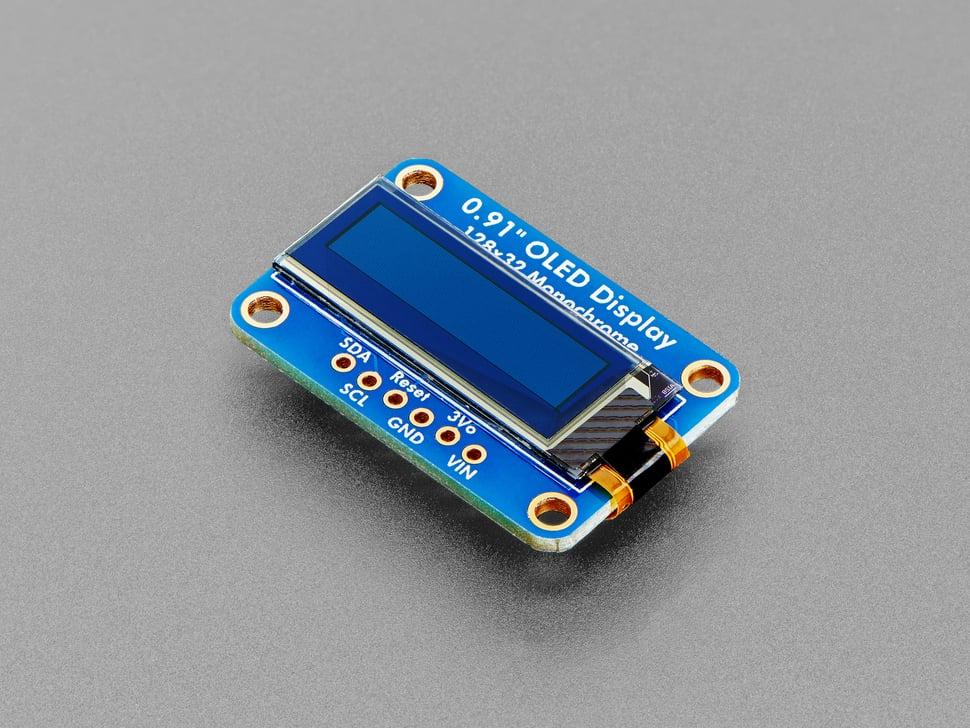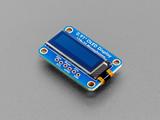Adafruit Monochrome 0.91" 128x32 I2C OLED Display - STEMMA QT / Qwiic

Description
These compact displays measure approximately 1 inch diagonally, featuring high contrast thanks to OLED technology. Comprising 128x32 individual white OLED pixels, each pixel operates independently through a controller chip. The self-illuminating quality of the OLED negates the need for a backlight, reducing power consumption and enhancing contrast, making the display exceptionally crisp.
For seamless integration, the OLED display is mounted on a breakout PCB with support circuitry, ensuring compatibility with 3.3V (Feather/Raspberry Pi) and 5V (Arduino/Metro328) logic levels. The design now includes auto-reset circuitry, making the reset pin optional, and supports I2C connection with just two wires, plus power and ground.
Featuring SparkFun Qwiic-compatible STEMMA QT connectors for the I2C bus, soldering is no longer a necessity. Simply connect using a STEMMA QT adapter cable (not included) and follow our detailed tutorial featuring both Arduino and Python/CircuitPython libraries for text and graphics. A microcontroller with over 512 bytes of RAM is required due to the need to buffer the display.
Power usage averages around 20mA from the 3.3V supply, dependent on the display's lighted area. The built-in simple switch-cap charge pump elevates 3.3V-5V to power the OLEDs effortlessly, making this an easy method to incorporate an OLED display into your project. Be mindful that each pixel is an organic LED, so turning off the display during inactivity helps prevent dimming from prolonged use.
Properties
| Brand | Adafruit |
| Model | 4440 |
Delivered in 10 to 30 days
Customer questions
Customer Reviews
- In stock Adafruit NOOds - Flexible LED Filament - 3V 300mm long - Red € 7,25 View product
- In stock Adafruit IR Break Beam Sensors with Premium Wire Header Ends - 3mm LEDs € 2,90 View product
- In stock Adafruit Breadboard-friendly 2.1mm DC barrel jack € 1,05 View product
- In stock Adafruit IR Break Beam Sensor with Premium Wire Header Ends - 5mm LEDs € 5,80 View product
- In stock Adafruit Small Enclosed Piezo w/Wires € 1,05 View product
- In stock Adafruit Mini Basic PIR Sensor - BL412 € 2,10 View product
- In stock Adafruit Stainless Thin Conductive Thread - 2 ply - 23 meter/76 ft € 6,85 View product
- In stock Adafruit NOOds - Flexible LED Filament - 3V 300mm long - Blue € 7,25 View product
- In stock Adafruit 2 x CR2032 Coin Cell Battery Holder - 6V output - On/Off switch € 2,10 View product
- In stock Adafruit Pressure-Sensitive Conductive Sheet (Velostat/Linqstat) € 4,75 View product
- In stock Adafruit Stacking Headers for Feather - 12-pin and 16-pin female headers € 1,25 View product
- In stock Adafruit Stereo 3.7W Class D Audio Amplifier - MAX98306 € 8,70 View product
- In stock Adafruit Mono 2.5W Class D Audio Amplifier - PAM8302 € 3,95 View product
- In stock Adafruit White LED Backlight Module - Medium 23mm x 75mm € 2,50 View product
- In stock Adafruit NOOds - Flexible LED Filament - 3V 300mm long - Lime Green € 6,85 View product
Recently viewed items
- Adafruit Monochrome 0.91" 128x32 I2C OLED Display - STEMMA QT / Qwiic € 12,- View product
- SparkFun USB LiPoly Charger - Single Cell € 18,90 View product
- Adafruit XBee Module - Series 1 - 1mW with Wire Antenna € 22,15 View product
- Adafruit Coin Acceptor - Programmable 4 Coin Type € 38,45 View product
- Adafruit Anidees Black Case w/ Smokey Top for Raspberry Pi B+/Pi 2/Pi 3 € 38,45 View product
- Adafruit Saleae Logic Pro 16 - 16 Channels Logic + Analog - Black € 959,50 View product
- Adafruit NeoPixel LED Strip w/ Alligator Clips - 60 LED/m € 12,- View product
- Adafruit Mini USB WiFi Module - RTL8188eu - 802.11b/g/n € 11,60 View product
- Adafruit USB Type C SMT / THM Jack Connector - Pack of 10 € 8,70 View product
- Adafruit 0.8" 8x16 LED Matrix FeatherWing Display - Red € 11,60 View product
- Adafruit ADXL375 - High G Accelerometer (+-200g) with I2C and SPI € 24,- View product
- Adafruit USB Host Switching Cable - Mini Mechanical KVM € 19,25 View product
- Adafruit Clear Turbine Water Flow Sensor with 3-pin JST € 6,45 View product
- Adafruit NeoPixel LED Outdoor Netting - 100 x 20 LEDs - 1x5 Meter Sizing € 431,45 View product
- Snap-on Enclosure for Adafruit Mini Sparkle Motion € 3,55 View product










